Cutting-edge bomb detection sensors
The upsurge in IEDs is a result of the abundance of information available for building them and the relative ease with which products such as chemical substances can be obtained. No specialised sensors exist to detect traces of bomb-making materials. With this in mind, the EU-funded BONAS (Bomb factory detection by networks of advanced sensors) project set out to create a novel wireless sensor network that detects chemical traces of explosive vapours in the air. This helps to provide early warning to security services while protecting the public from IED threats. Project partners designed and developed a network and accompanying in situ and remote sensing devices for a broad range of compounds and with low false alarm rates. The BONAS technological solutions were tested by monitoring various suspicious substances at a military airport in Italy and at the Swedish Defence Research Agency jointly with the FP7 EMPHASIS project. All devices can be hidden with ease and some are handheld. Security services are able to identify a bomb inside a building or vehicle with sensors that monitor the chemical composition of molecules in the air outside. The sensors are installed in a network to alert law enforcement officers if any traces of explosives are detected and counterterrorism units well in advance of a planned terrorist action. To find a bomb factory, sensors are deployed to analyse volatile compounds, airborne particle residue and traces in wastewater in a suspected zone. When the search is narrowed to a suspected hideout, additional sensors are deployed. BONAS introduced fully developed detection technologies to effectively mitigate the production of homemade bombs. As a result, IED threats will more easily be thwarted.
Keywords
Bomb detection, sensors, bomb factories, improvised explosive devices, explosives, bomb factory







